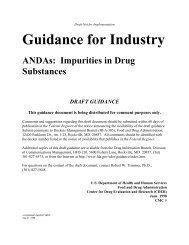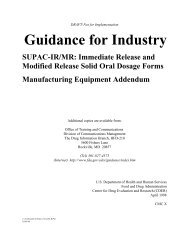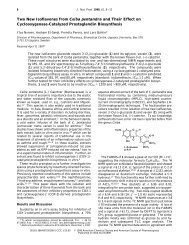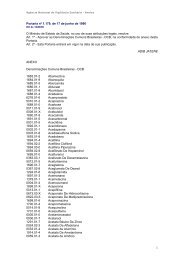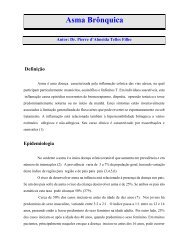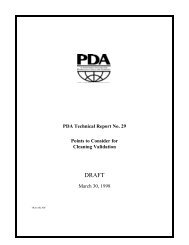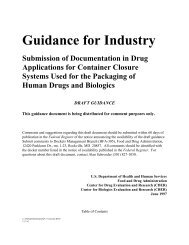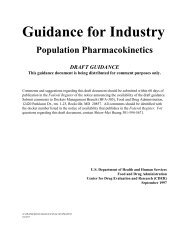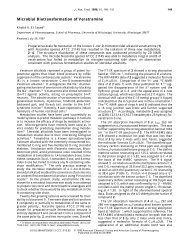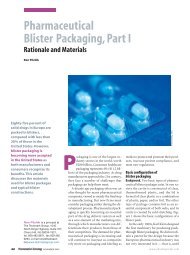Bioanalytical Methods Validation for Human Studies - Pharmanet
Bioanalytical Methods Validation for Human Studies - Pharmanet
Bioanalytical Methods Validation for Human Studies - Pharmanet
Create successful ePaper yourself
Turn your PDF publications into a flip-book with our unique Google optimized e-Paper software.
Draft — Not <strong>for</strong> Implementation<br />
A calibration curve should be generated <strong>for</strong> each analyte to assay samples in each analytical run<br />
and it should be used to calculate the concentration of the analyte in the unknown samples in the<br />
run. The spiked samples may contain more than one analyte. An analytical run could consist of<br />
either all the processed samples to be analyzed as one batch or a batch composed of processed<br />
unknown samples of one or more volunteers in a study, QC samples, and calibration standards.<br />
The calibration (standard) curve should cover the expected unknown sample concentration range<br />
in addition to a calibrator sample at LOQ. Estimation of concentration in unknown samples by<br />
extrapolation of standard curves below LOQ or above the highest standard is not recommended.<br />
Instead, the standard curve should be redefined or samples with higher concentration should be<br />
diluted and assayed (Shah 1992). All study samples from a subject should be analyzed in a single<br />
run.<br />
Once the analytical method has been validated <strong>for</strong> routine use, its accuracy and precision should<br />
be monitored regularly to ensure that the method continues to work satisfactorily. To achieve this<br />
objective, a number of separately prepared QC samples should be analyzed with processed test<br />
samples at intervals based on the total number of samples. The QC samples in duplicate at three<br />
concentrations (one near the LOQ (i.e., #3 x LOQ), one in midrange, and one close to the high<br />
end of the range) should be incorporated in each assay run. The results of the QC samples<br />
provide the basis of accepting or rejecting the run. At least four of the six QC samples should be<br />
within ±20% of their respective nominal value. Two of the six QC samples may be outside the<br />
±20% of their respective nominal value, but not both at the same concentration (Shah 1992,<br />
Brooks 1985, Buick 1990, Mehta 1989, Ayers 1981).<br />
VI.<br />
DOCUMENTATION<br />
The validity of an analytical method should be established and verified by laboratory studies.<br />
Documentation of successful completion of such studies should be provided in the assay<br />
validation report. Protocols that define a set of specific directions that must be followed are<br />
important if the analytical results are useful <strong>for</strong> a given purpose.<br />
General and specific SOPs and good record keeping are essential parts of a validated analytical<br />
method. The analytical protocols and SOPs should be signed and dated by the laboratory director<br />
and updated regularly. The SOP should state situations under which reassay of samples is<br />
permitted. Reassays should be done in triplicate.<br />
The pre-study validation experiments, the data generated from them, and the assay quality control<br />
data should be recorded in a bound laboratory notebook. The entries should be signed by the<br />
chemist and witnessed by the laboratory supervisor. All records should be available <strong>for</strong> data audit<br />
and inspection.<br />
Documentation <strong>for</strong> pre-study validation should include:<br />
j:\!guidance\2578dft.wpd<br />
12/14/98 10



